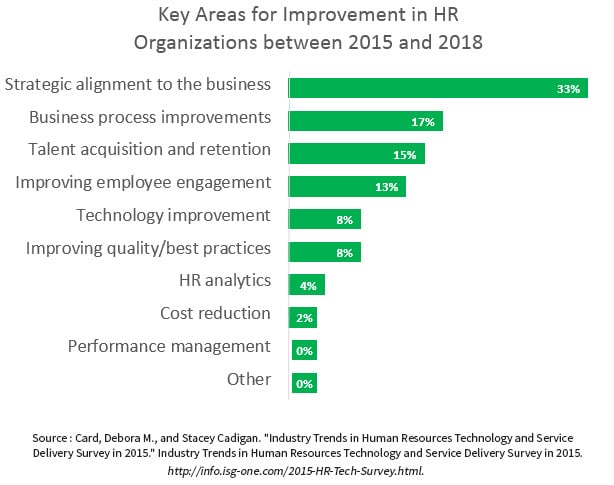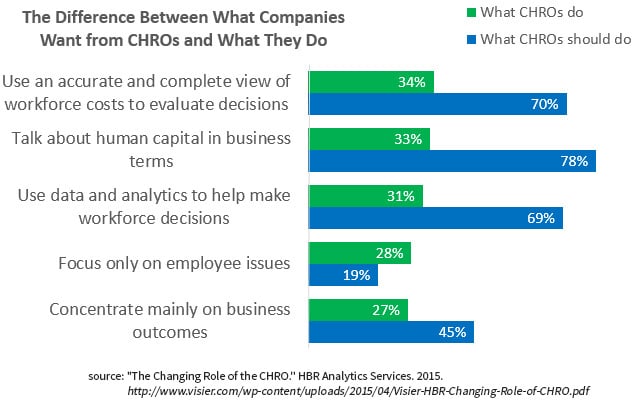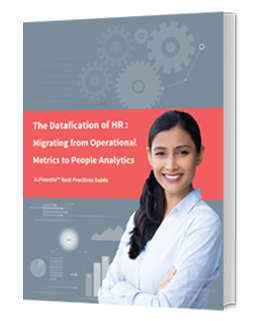
We have been hearing and discussing the need for HR leaders to become strategic partners for 25 years. Until recently only a small percentage of CHROs were able to achieve it. The primary reason is the accurate perception of HR as transaction processors and internally-focused practitioners of people management. We can change that perception.
Strategic Alignment is the Top Priority
Strategic alignment is a high priority. The annual Information Services Group (ISG) survey on HR on service delivery trends placed strategic alignment at the top of planned improvements in HR.

That report also showed us that improving HR analytics capabilities and value is not a priority, and that is a barrier to alignment. Until practitioners cross that barrier, true alignment will not exist. How can strategic alignment happen if we do not analyze our processes and align them with quantitative business outcomes? It is the logical starting point that enables us to speak the language of the enterprise.
Changing HR Roles
A significant shift in human capital management technology has changed roles in HR -- but there still is a difference between what business leaders want HR to do and what HR is doing. A 2015 Harvard Business Review Analytics Services Report quantified the gap and gave us a clearer picture of both the problem and the solution.

Analytics: Problem and Solution
The common thread is analytics. The gaps relate directly to the need for the flow of information related to business outcomes. We cannot even begin to address the alignment issues until learn how to analyze the data.
A robust analytics function will not only provide the information HR needs to align itself with the business, but it also provides the language necessary to engage in the business conversation. It will change the conversation from internal efficiency measures to outcomes like cost, revenue, and return on investment. People create revenue, and we can measure their impact. Sometimes we only have derivative measures, but the proper analysis will demonstrate the value.
What is Holding You Back?
Let us offer some answers to the obstacles in your way. HBR Analytics Services surveyed leaders and practitioners to learn why we have not seen more adoption of HR analytics. We provide comments on each of them.

Inaccurate, inconsistent, or hard-to-access data. No one has perfect data. Many hands touch your data in many ways. No matter how hard you try, it is going to be a bit messy.
Payroll data needs to be exact. Turnover data does not. Does it matter whether you are losing 35% or 45% of your high-performing employees? Can you take action on the information?
If necessary, services are available to help you clean your data. We can design algorithms that will help with accuracy, but we all need to acknowledge that our data will never be pristine.
If your HR data is hard to get, your IT team should be able to help. If not, many very reliable consulting companies can help.
Another thing to consider: If your information is so hard to get, is it time to upgrade your technology?
Lack of analytical acumen or skills in HF. Most of analytical skill is learning how to ask the right question. One of the best places to start is in return on training investment. If you provided sales skills training, did it increase revenue? If you provided customer service training, did average revenue per employee increase? In recruiting, did your new assessment improve hiring manager satisfaction? Did it lower turnover? If so, how much did it lower turnover cost?
Analytical skills training is everywhere, and much of it is free. Udemy offers a complete training course at a very reasonable cost.
Lack of adequate investment in analytics. If you are changing or upgrading your HR software, now is the time for analytics. Almost all HR software platforms provide some level of analytics built in, and the capabilities are getting better and easier to use. Separate analytics platforms are coming to market with lower costs and better capabilities. We wrote recently about how to get started with no budget. It describes how you can use a small success to build your case for better tools.
Lack of a data-driven culture. Partner with Finance, Marketing, Sales, and Logistics to change the culture. They need data analytics as much as you do, and they are probably looking for HR solutions for their productivity problems. In our experience, if your leadership is not data driven, one analytics success will change their minds.
Lack of Support by C-Suite. You can overcome this with alliances. Work with business leaders to solve their problems and measure their success and the impact on business results. Nothing gets the C-Suite’s attention like improved results.
HR does not know how to talk about business outcomes. Learning the business should be your top priority. Your allies in Finance, Marketing, Sales and Operations will help you with this if you reach out.
Take the First Step
To become a strategic business partner, HR must apply the same analytical discipline that Finance, Marketing, Logistics, and every other business function has been using for many years. If you partner with them, we think you will be surprised at the amount of help available in your organization.
References
"The Changing Role of the CHRO." HBR Analytics Services. 2015.
"HR Joins the Analytics Revolution." HBR Analytics Services. 2014.
Phenomecloud is a full-service technology company dedicated to helping clients solve business problems, improve the capability of their people, and achieve better results.






Leave a Comment